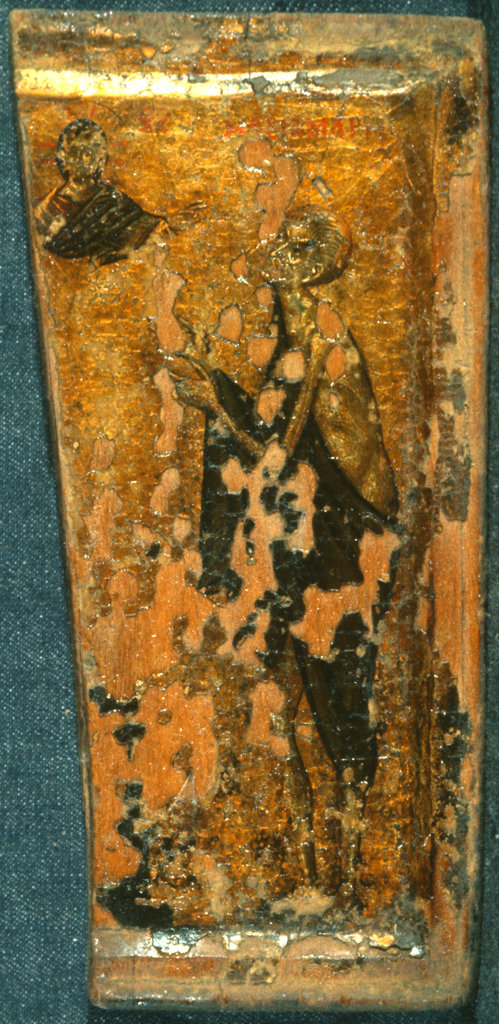Today, and again on Wednesday, as it so happens, we remember our venerable mother Mary of Egypt.
Before her repentance, she was, as Simon the Pharisee observed today about the woman of the city, “a sinner” (Luke 7:39) Though she is often thought of as a prostitute, her sin was not so much prostitution as fornication. Saint Sophronios says that she would not charge her many sexual partners, but survived instead by begging and spinning flax. She was, like so many of us in this hypersexualized culture, consumed and driven “by an insatiable and an irrepressible passion” of lust.
She went to Jerusalem among the pilgrims, but her reason for going was not pilgrimage. Rather, she went in a large group for the purpose of seducing many partners. Some might question how such a sinner could even think to enter the holy city and its holy places.
But remember the woman of the city in Simon’s house today. She goes right up to Jesus himself and, weeping, wets his feet with her tears and wipes them with her hair and kisses his feet and anoints them (Luke 7:37-38). Though she is a sinner, she touches Jesus. And Jesus, who is more than a prophet, knows that she is a sinner, yet allows her to touch him.
On the other hand, when Mary of Egypt, who is also a sinner, tries to enter the house of Jesus – that is his Holy Sepulchre in Jerusalem, the Church of the Anastasis – of the Resurrection – she is prevented by an invisible spiritual force from entering the church.
Why? What’s the difference between these two sinful women? Why does Jesus allow one to touch him while the other is prevented from even entering his house? There is only one difference between them – repentance. The woman of the city in the Pharisee’s house was penitent. She was weeping. And she was loving. She did not cease to kiss Jesus’s feet. So all her many sins were forgiven because she loved much.
Meanwhile, Mary of Egypt tries to enter the holy place of the Lord while yet impenitent. She goes to that holy tomb not seeking to anoint the body of the Lord, but rather seeking more partners for her lust. The invisible blockade that she experiences is in fact a strong medicine. It’s not meant, I don’t think, simply to keep the holy separated from the unholy – the clean from the unclean, but it is meant, I think, to reveal her situation to her and to bring her to repentance.
And, gracefully, it has this effect. Seeing outside the church an icon of another Mary – that is, of the most pure Theotokos – she does repent. She weeps and laments, like the woman of the city in the Pharisee’s house. And she learns that true love for the Lord surpasses any self-satisfaction gained by indulging in the passion of lust. Trying again, in her new state of penitence, to enter the Church of the Resurrection, she finds no force keeping her out. And she does enter and there she kisses the Holy Cross, just as the woman of the city kissed the feet of Jesus. She who is forgiven much loves much.
Now what might her fellow pilgrims have thought of her at this moment? Seeing this woman who they knew to be among their number expressly for the seduction of their members, now entering the Holy Sepulchre weeping and kissing the Holy Cross, what might they have thought? When Simon saw the sinful woman enter his house and kiss the feet of Jesus, he thought, “If this man were a prophet, he would have known who and what sort of woman this is who is touching him, for she is a sinner” (Luke 7:39). If Mary’s fellow pilgrims were true followers of Christ, then they rejoiced at her repentance. But if they were like some of us, then they probably had thoughts rather similar to Simon’s. They may have thought “Who is this woman to kiss the Holy Cross? She has not embraced the cross by her dissolute living.” They may have judged her and thought her presence among them in this place at this time inappropriate.
I hope not. But if they did, the only true judge knew their thoughts. And if we have thoughts like this about others, he knows this as well, and we will hear about it. Let’s rather keep our thoughts on our own sins rather than on the sins of those around us.
For things are often not what they seem. A person who seems to us to be a great sinner may, in fact, be awash in the holy grace of forgiveness through repentance.
This was the case with Mary of Egypt. She seemed to be still a great sinner, but in truth, her glorification by grace, by the life of God, had already begun. She went immediately after her eyes were opened to the holy mystery of repentance, was absolved of her sins, and received holy communion. This is the proper, ordinary, and churchly way to begin again the life in Christ after we have sinned. When we fall, we get up again. When we sin, we repent and enter again into the communion with the Lord through the mysteries of the Church.
But then Mary did something less ordinary, less usual, and even less churchly by some standards. The next morning, she crossed the river Jordan and then lived the rest of her life – 47 years – in the desert as a hermit.
I say this is a less churchly way of life because, for one thing, it is extremely peculiar for a person to be called directly into the life of a hermit – without first having lived a long time in community. (Though, there are other examples of this – particularly in early monasticism – such as St. Antony the Great.) And then, even among hermits, it is peculiar to live most of life deprived of the holy mysteries, especially the Eucharist. Yet this is what Saint Mary of Egypt did. After that first holy repentance and communion, she went into the desert and never communed again, until the day that she died many years later.
We who are now deprived of church services because of the coronavirus are experiencing a relatively brief taste of the life that St. Mary lived for 47 years. If we use this time like she did – for repentance – we will come out on the other side of it not deprived of grace but still more illumined by grace.

A year before St. Mary died, St. Zosima, a priest, came upon her in the desert. Her hair was so long and she was so rough from her many years of ascetic practice, that from a distance he did not at first know for sure whether she was human. She told him her life story and she asked him to bring her holy communion the following year on Holy Thursday, which he did, on the banks of the Jordan – the same place she had received communion the last time. When she came to receive communion from him, for the second and last time of her life, she walked on the water of the Jordan to meet him.
Seeing this miracle, Zosimus began to prostrate himself, but she cried out to him and stopped him, “What are you doing Abba! You are carrying the divine Gifts!” Behold her reverence for the Eucharist, despite her forty-seven years of abstinence from it. When we carry the Divine Gifts – our Lord’s own body and blood, we do not kneel or prostrate, as if to make the Lord bow before his creatures. We do not kneel after holy communion, while we carry our Lord within our very bodies. To make a gesture of penance while communing with the Lord expresses – falsely – that the holy communion has failed in its purpose, which is to unite us to the Lord, in whom death has been vanquished. We stand for communion in expression of this resurrectional faith. Resurrection, anastasis, means “to stand again.” St. Mary understood this.
St Mary of Egypt understood much, despite the fact that she never went to church again after her illumination. When she did receive the Eucharist that second and last time, it was brought to her by the priest. She did not go to church. This might astound us. We humans have a rule book and a script that we think must be followed in order to grow in union with God. But God doesn’t follow the script. He who can raise up children of Abraham out of the stones can make us saints even if we are distanced from the liturgy. And St Mary knew how to worship the Lord in the Eucharist better than the priest who brought him to her! This woman who didn’t go to church for 47 years understood the Eucharist better than the priest! Frequent communion is a good thing, but it is not the only way to holiness.
Here is a woman who defies all of our expectations. Living apart from church services, even apart from frequent reception of holy communion, and yet living a life filled with grace and faith. Mary demonstrates that God can and does act as he will. He is not confined by us or by our expectations. We do not limit his grace.
